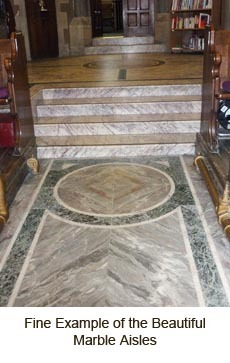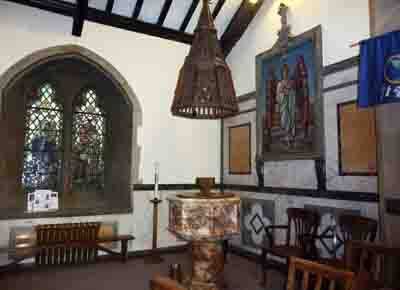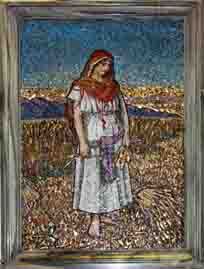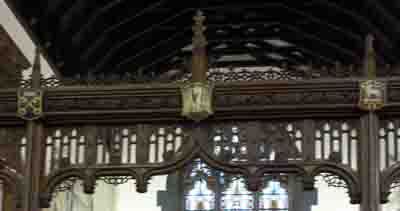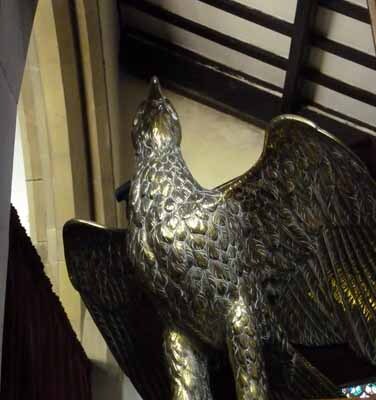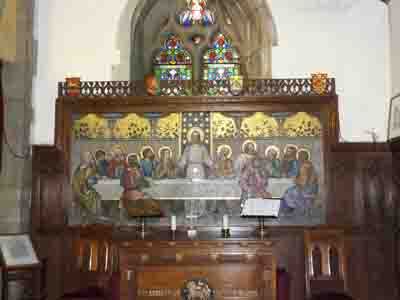How The Parish Church Came To Be Built
|
Entry Through The Main (South) Door
On entering the building the first thing which strikes the visitor to Clayton Parish Church is its wealth of marble, some of which is extremely rare and is in some instances now no longer quarried and therefore irreplaceable and also the beautiful glass mosaics. We begin our tour in the left hand corner as we enter and move around the building in a clockwise direction. |
The Nave and AislesThe flooring here came in the main from Devon. The central passage of the Nave and North and South Aisles are laid with grey Petitor marble from Devon with bands of green Tinos and Skyros from Greece. The Dado which is the marble skirting which runs along the lower part of the North and South Aisles has a Cippoline marble plinth (from Euboea) with a background above of Greek Skyros, inlaid with other marbles to form the “four— leafed clover” and diamond shaped panels, etc. |
The Baptistry
|
The War Memorials
|
The West End Mosaic (North Aisle)
This superb mosaic portrays “Ruth” the Moabitess, gleaning the harvest field of Boaz her kinsman. The artist originally intended to produce the work in oils but tried a bold experiment of presenting the subject through the medium of tessalation and it was a complete sucess. |
The North Side Windows“THE SERMON ON THE MOUNT” WINDOW (the window next to the “Ruth” mosaic) has two lights combining to form one picture. The Lord is seated on the hillside, speaking earnestly to the group of listeners around Him. Stretched across the apex of the two lights is a scroll bearing the quotation from St. Matthew 5 : 1 “And when He was set, His disciples came unto Him.” The glorious colouring of this picture together with the rocks, rock plants and typical sky help to create a most beautiful and impressive New Testament scene.
"THE INCIDENTS OF THE SOUTHERN CAMPAIGN” WINDOW directly faces the worshipper coming into church by the south porch. The two incidents displayed took place probably on a journey from Galilea to Judea via Perea. The left hand light shows Jesus in the act of blessing the children (Matthew 19 : 14) “Suffer little children and forbid them not, to come unto me : for such is the Kingdom of Heaven.” The right hand light illustrates Mark 10 52 “and Jesus said unto him, go thy way; thy faith hath made thee whole. And immediately he received his sight and followed Jesus in the way”. The blind man Bartimaeus is pictured kneeling at the feet of Jesus, whose healing hand is held over the sightless eyes, while three spectators stand by. “THE PASTORAL COMMISSION” WINDOW — the middle one in the north aisle — has a setting comparable to a beauty spot in the Lake District. A scroll in the left light bears the wording of the divine commission “Feed my Sheep” John 21 : 17. Simon Peter is shown kneeling before the Risen Lord who stands, holding in his left hand a shepherd’s crook — the symbol of His care as the “good” and “Chief” shepherd, and with his right hand uplifted in teaching. The shield on the right displays the arms of the ancient Parish of Bradford. The left shield bears the Arms of the Diocese of Bradford. THE “MOTHER AND SON” WINDOW — second from the organ. The two lights each bear a figure set in a niche of elaborately carved stone work. The figure on the right is Elizabeth, the wife of the aged priest, Zacharias. On the left is her son, John the Baptist. Elizabeth holds in her hand an open book bearing the inscription “P’phetia Malachiae. Ecce ego mitto Angelum.” This is an old English script and approximates to the prophetical Latin of Malachi 3 : 1 “Behold I will send my messenger”. John carries a cross— topped staff, a labarum with the picture of a lamb, and inscription on the scroll reads “Ecce Agnus Dei”, (Behold the lamb of God). Above the principal figures in each light are two tiny angels. One in each pair blows a golden trumpet. Below these figures there are six initial letters — three in each light and four of them are surmounted by crowns. The initials are “E” for Elizabeth and “I” for John — there being no J. in Latin. THE “DOUBLE SERVICE” WINDOW — nearest the organ. The scripture quotation in the left light reads “I was a stranger and ye took me in.” Above is an aged pilgrim with staff and water bottle being received and welcomed by a householder at the portico of a palatial mansion. On the right above the text, “Naked and ye clothed me” is an aged poverty stricken wayfarer and two ragged children being succoured by a kindh earted lady. |
The Organ
|
The Pulpit
|
The Chancel Screen
|
The Lectern
|
The East WindowThe east window has three main “lights” separated by substantial stone mullions. Each light is divided into two sections and each section has a subject to itself, so that altogether there are six scriptural subjects pictorially illustrated in the three large lights. In the circular design above these three lights are three inverted trefoils with pleasing designs of vine leaves and tendrils. In the centre of each trefoil pattern is a sacred monogram. Over each of the outer main lights is a trifoliated opening with a central heraldic design surrounded by leaves and tendrils as before. The design on the left represents the “Agnus Dei”; that on the right a pelican with her brood. The main centre light, upper section, depicts Christ holding in his left hand a cross while his right hand is upraised in blessing. A Latin title “Salvator Mundi” (Saviour of the World) is seen underneath. The lower section of the middle light has for its subject “The Ascension”. Our Lord is seen rising from the midst of a group of His followers. The left hand has in its top portion, St. Thomas. He is holding a joiner’s square since tradition says he was a carpenter. The figure in the lower section is St. Peter, his left hand holds a large key; the right hand is raised in benediction. The top figure of the right hand light is St. John the Baptist. In his left hand he holds a staff surmounted by a cross. From the staff streams a “Vexillum” of pennon, which is inscribed “Repent Ye”. His right hand with a beckoning forefinger is raised high. St. Paul is the subject of the bottom panel of this light. He is portrayed with the book of the Gospel in his right hand, while his left hand rests upon a sword hilt. The inscription running along the bottom of the window under the three main lights; and which cannot now be seen from the floor level because of the marble reredos reads as follows: “To the glory of God, and in memory of Thomas Hirst, Esq., of Low House, Clayton, who died on the XV day of July MDCCCXL; also of Sarah his wife died on the XXth day of March MDCCCLVII. ‘her children arise up and call her blessed Prov. XXXI, V. XXVIII”. |
The Chancel
|
The Memorial Chapel
|
The Two Chapel WindowsEast — two lights. St. John the Evangelist occupies the right light. Both hands hold a book in front of his body, the right hand also holding a quill. Over the Saint is the reference IOHN XXI Ver XXIV (“This is the disciple which testifieth of these things, and wrote these things; and we know that his testimony is true”. Underneath the figure is Lhe title “ST. JOHN THE EVANGELIST”. In the left light is a female figure with the tit}è “ST MARY MACDALEN”, with both hands she clasps an ornamental vase. Overhead is the reference “JOHN XIII VER III”. This passage refers to Mary of Bethany, not to Mary Magdalen and the words “Then Mary took a pound of ointment of spikenard, very costly, and annointed the feet of Jesus, and wiped his feet with her hair; and the house was filled with the odour of the ointment. South — One Light. This lovely little window shows the risen Lord ascending into Heaven from Olivet. Note the olive trees in the foreground and Jerusalem in the lower background. The nail prints are visible in the feet and the right hand. As the Lord ascends, a choir of angels welcome Him to the Heaven of Heavens. |
The South Side WindowsTHE “SAMARITAN” WINDOW is a two light window and is nearest to the Memorial Chapel. The subject is the Parable of the Good Samaritan (Luke X: 30—37). On the right hand side are pictures of the Priest and the Levite. In the left light we see the wounded Jew being tended by his Samaritan rescuer while the patient ass awaits its new burden. THE “TWO HOMES” WINDOW — entitled so because it depicts the two earthly homes of the Lord Jesus. In the right light the boy Jesus is seen with His right knee resting on a joiner’s bench and holding a tool which he strikes with a hammer or mallet. His mother sits nearby and has ceased her work of spinning to gaze intently at her young son. Underneath this picture are the descriptive words from St. Luke 2: 51 “He went down with them, and came to Nazareth and was subject to them.” In the left light we see Jesus with Martha and Mary in the home at Bethany. Mary is kneeling at the feet of Jesus with her hands clasped in an attitude of rapt attention. Martha is standing near, and is holding a domestic water jar. Beneath this Bethany scene is the quotation from Luke 10:42 “Mary hath chosen that good part, which shall not be taken away from her.” THE “GOOD COMPANIONS” WINDOW — third from the side chapel and adjacent to the South Porch. On the right is the figure of the great Apostle to the Gentiles with the caption “St. Paul, the Untiring Missionary.” On the left is the figure of the accomplished Christian doctor, bearing the caption “St. Luke, the beloved Physician.” |
Memorials
|
___
|
|
|
|
|
|
|
|
|
|
|
|
|
|
|
|
|
|
|
|
|
|
|
|
|
|
|
|
|
|
|

